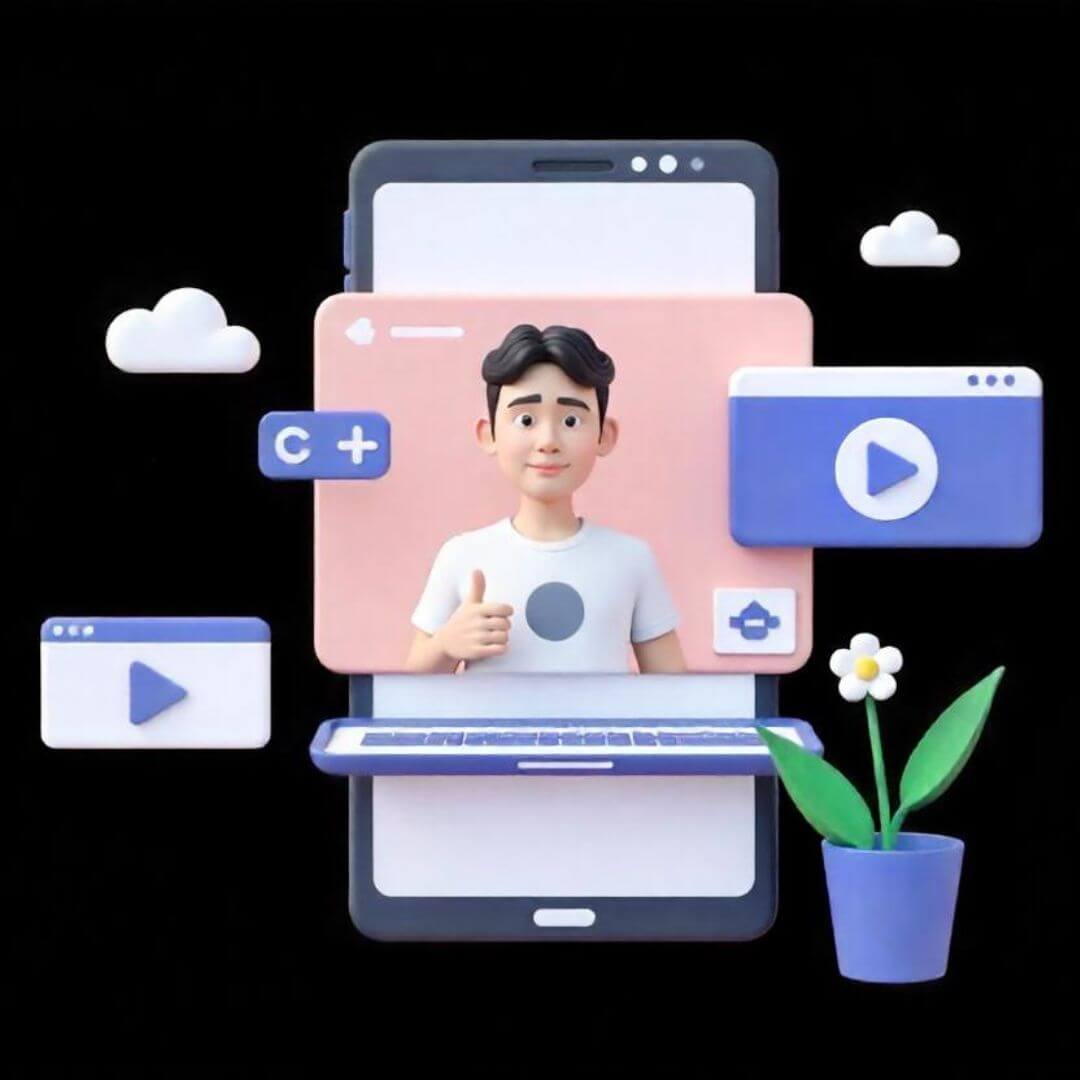The educational landscape has undergone a dramatic transformation in recent years, largely due to the rapid growth of technology and digital learning. No longer do students solely rely on textbooks and traditional classroom setups to access knowledge. Today, educational platforms use a variety of tools to make learning more engaging, efficient, and accessible. One such tool that has proven to be especially effective is App Videos. These videos not only showcase how to use educational apps but also provide visual and interactive demonstrations that enrich the overall learning experience.
The importance of educational videos in the educational industry cannot be overstated. In an increasingly tech-savvy world, students are looking for interactive, easily digestible content, and video is a great way to deliver this. This blog post will provide an in-depth exploration of how to create App Videos that enhance user experience and engagement for educational platforms.
Why Are App Videos Crucial for Educational Platforms?
App Videos play a crucial role in modern education, as they allow users to understand the full potential of an educational platform or app. The integration of video into the learning experience does more than just convey information – it transforms passive learning into an engaging and dynamic process. Here are several reasons why App Videos are essential for educational apps:
- Enhancing User Understanding Educational videos are particularly useful for breaking down complex concepts or functionalities in a way that is easy to understand. For example, if your app contains multiple features or tools, a video can visually demonstrate how to navigate through the app, thus ensuring that users can effectively use all its capabilities.
- Increased User Engagement Studies have shown that people are far more likely to engage with videos than with static text or images. Videos hold the viewer’s attention, which is essential when trying to keep students engaged with your educational content. Videos can explain challenging concepts, provide context, and answer frequently asked questions, all while making the content much more digestible.
- Improving Retention When paired with voice narration and visual elements, videos tend to boost information retention significantly. Research supports the idea that students retain information more effectively when it’s delivered through educational videos than when it’s delivered through other mediums. As apps become the cornerstone of modern education, this is crucial for long-term success.
- Increasing Accessibility One of the biggest advantages of App Videos is that they can be accessible at any time and from any place. This is especially beneficial for self-paced learning platforms where students can revisit content whenever they need clarification. Moreover, videos can include closed captions or subtitles to accommodate students with hearing impairments.
- Showcasing App Features and Benefits App tutorials are an excellent way to showcase your educational platform’s features and demonstrate how they can be used to improve learning outcomes. Whether you’re explaining how to track progress, engage with gamified elements, or access study materials, a video tutorial helps guide users and encourages them to explore the app’s full potential.
- Boosting Conversion and Retention Rates Educational apps are becoming increasingly competitive, and App Videos can play a significant role in improving conversion rates. A well-executed video can show potential users the value of your app, explaining how it can help them achieve their learning goals. If your video content is compelling enough, it may convince them to sign up and continue using your platform.
Planning Your App Video Strategy
Before you begin creating App Videos for your educational platform, it’s important to develop a strategy that aligns with both your educational goals and marketing objectives. Here are several key steps to keep in mind when planning your educational videos:
1. Understand Your Target Audience
The first step in creating effective App Videos is to understand the audience you’re targeting. Different age groups, educational levels, and interests require different approaches. Here are a few things to consider when defining your target audience:
- Age Group: Are you targeting younger learners, such as elementary school children, or are your videos geared towards college students or adults? The tone, content, and complexity of your videos will differ depending on the age group.
- Learning Preferences: Some students prefer hands-on, interactive learning, while others prefer more traditional forms of content. Videos can combine both, offering interactive elements such as clickable links, quizzes, and challenges.
- Tech Savviness: Make sure your videos are designed to match the technological familiarity of your target audience. Younger audiences might be more tech-savvy and accustomed to mobile apps, while older audiences may require a more straightforward approach.
By defining your audience, you can better tailor the content, style, and structure of your App Videos to ensure they resonate with your viewers.
2. Decide on the Type of Video Content
There are several types of educational videos you can create for your educational platform. Each type has its benefits and can be used for specific purposes:
- Explainer Videos: These are great for introducing users to the app and explaining its core features. Explainers usually offer a simple, high-level overview without diving too deep into complex topics.
- How-to or Tutorial Videos: These videos offer step-by-step instructions, showing users how to navigate through the app and access specific tools. Tutorial videos are ideal for ensuring that users understand how to use all of the app’s functionalities.
- Feature-Focused Videos: If your app has specific features that differentiate it from other educational platforms, consider creating videos that showcase these features in more detail. For example, you could create a video demonstrating how to use interactive quizzes, track learning progress, or engage with collaborative tools.
- FAQ and Troubleshooting Videos: To address common user problems or frequently asked questions, you can create a series of videos that provide solutions. These videos can help improve user satisfaction and reduce frustration with your app.
By deciding on the type of video content, you can create a video strategy that meets the needs of your users and ensures your educational platform’s success.
3. Plan for Length and Engagement
One of the key aspects of creating effective App Videos is ensuring they are the right length. You don’t want your videos to be too long, as users may lose interest. On the other hand, you don’t want them to be too short, as you may not have enough time to explain essential concepts.
- Short Explainers: For introductory content, aim for videos between 1 to 3 minutes. This is long enough to provide a clear overview without overwhelming the viewer.
- In-depth Tutorials: More detailed videos, such as those showing users how to navigate through multiple features, maybe slightly longer (4 to 8 minutes). You can break longer tutorials into smaller chapters or parts to prevent viewers from feeling overwhelmed.
The goal is to balance thoroughness with brevity while ensuring that your videos remain engaging.
Creating High-Quality App Videos
Creating App Videos that capture the viewer’s attention while providing valuable educational content requires attention to several important aspects. Here’s a guide to help you create high-quality videos:
1. Script Writing and Storyboarding
Before you start recording, write a clear script that outlines the flow of your video. This script should describe the steps the user will follow, the key features of the app that will be highlighted, and any additional information needed. Additionally, creating a storyboard for your video will help you visualize the scenes and transitions, making the production process smoother.
2. Visual and Audio Quality
Ensure that your videos are of high quality in both visual and audio aspects. Poor video or audio quality can detract from the learning experience. Invest in high-quality cameras, microphones, and editing software to produce professional content. If you are recording screen tutorials, use a screen recording tool that captures smooth video without lag.
3. Engage with Animation and Graphics
Incorporating animations, text overlays, and graphics into your videos can make them more engaging. Use simple animations to emphasize key points or to visualize abstract concepts that might be difficult to convey through traditional video footage. However, avoid overloading the video with too many animations or effects, as this could distract viewers from the core content.
4. Optimizing for Mobile Devices
Since most users will access your educational app on their smartphones or tablets, it’s important to optimize your videos for mobile devices. Ensure that your videos are mobile-friendly by testing them on various screen sizes and adjusting the layout, resolution, and text size accordingly.
5. Add Subtitles and Transcripts
To make your App Videos accessible to a broader audience, consider adding subtitles and providing transcripts for each video. Subtitles not only improve accessibility for users with hearing impairments but also help viewers follow along in noisy environments or when they prefer to read.
SEO Optimization for App Videos
To maximize the impact of your educational videos and ensure they reach your target audience, SEO optimization is key. Here are some effective SEO strategies for App Videos:
- Title and Description Optimization
- Use relevant keywords such as educational videos, App Videos, and other related terms in your video title and description. This will help search engines index your video, improving its discoverability.
- Tags and Metadata
- Tag your video with appropriate keywords, including the name of the app, its main features, and related topics in the educational industry. This will help your video show up in related search results.
- Transcriptions and Closed Captions
- Providing video transcriptions and enabling closed captions not only helps accessibility but also improves SEO. Search engines can crawl the text in transcripts and captions, making it easier for users to find your video.
- Engagement Metrics
- Encourage viewers to engage with the video by liking, commenting, and sharing it. Engagement metrics like views, likes, and comments signal to search engines that the content is valuable, which can improve the video’s ranking.
Future Trends: App Videos in Education
As the educational industry continues to embrace digital learning, we can expect App Videos to evolve in exciting ways. With the integration of cutting-edge technologies like augmented reality (AR), virtual reality (VR), and artificial intelligence (AI), educational apps will be able to offer even more immersive and personalized learning experiences.
For instance, App Videos may soon include interactive elements like quizzes, games, and 360-degree videos that allow users to explore the content in real time. These innovations will offer endless possibilities for creating dynamic educational videos that adapt to the needs of individual students.
Conclusion
To sum up, App Videos are an invaluable asset for educational platforms. Whether you are trying to explain how to use your app, demonstrate its features, or guide students through a learning module, educational videos can enhance user engagement, improve retention, and drive growth for your platform. By planning your videos carefully, investing in quality production, and optimizing for SEO, you can create impactful videos that resonate with your audience and support their learning journey.
As the educational industry continues to evolve, App Videos will undoubtedly play an increasingly important role in the digital education revolution. By staying ahead of the curve and adopting the latest technologies, you can ensure that your educational platform remains at the forefront of the learning experience.


